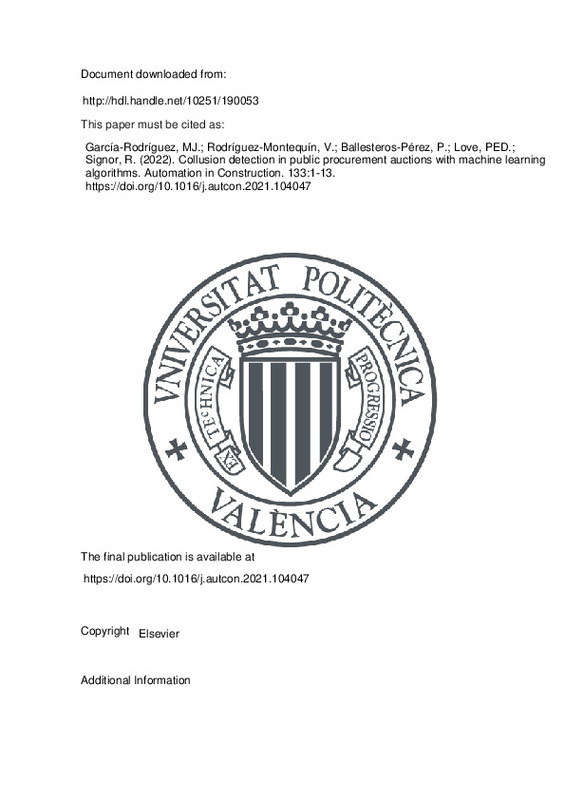JavaScript is disabled for your browser. Some features of this site may not work without it.
Buscar en RiuNet
Listar
Mi cuenta
Estadísticas
Ayuda RiuNet
Admin. UPV
Collusion detection in public procurement auctions with machine learning algorithms
Mostrar el registro sencillo del ítem
Ficheros en el ítem
| dc.contributor.author | García-Rodríguez, Manuel J.
|
es_ES |
| dc.contributor.author | Rodríguez-Montequín, Vicente
|
es_ES |
| dc.contributor.author | Ballesteros-Pérez, Pablo
|
es_ES |
| dc.contributor.author | Love, Peter E. D.
|
es_ES |
| dc.contributor.author | Signor, Regis
|
es_ES |
| dc.date.accessioned | 2022-11-22T19:02:48Z | |
| dc.date.available | 2022-11-22T19:02:48Z | |
| dc.date.issued | 2022-01 | es_ES |
| dc.identifier.issn | 0926-5805 | es_ES |
| dc.identifier.uri | http://hdl.handle.net/10251/190053 | |
| dc.description.abstract | [EN] Collusion is an illegal practice by which some competing companies secretly agree on the prices (bids) they will submit to a future auction. Worldwide, collusion is a pervasive phenomenon in public sector procurement. It undermines the benefits of a competitive marketplace and wastes taxpayers¿ money. More often than not, contracting authorities cannot identify non-competitive bids and frequently award contracts at higher prices than they would have in collusion¿s absence. This paper tests the accuracy of eleven Machine Learning (ML) algorithms for detecting collusion using collusive datasets obtained from Brazil, Italy, Japan, Switzerland and the United States. While the use of ML in public procurement remains largely unexplored, its potential use to identify collusion are promising. ML algorithms are quite information-intensive (they need a substantial number of historical auctions to be calibrated), but they are also highly flexible tools, producing reasonable detection rates even with a minimal amount of information. | es_ES |
| dc.description.sponsorship | The authors are grateful to the Swiss Competition Commission (COMCO) and Dr. David Imhof for their valuable comments and sharing some of the collusive datasets used in this paper. | es_ES |
| dc.language | Inglés | es_ES |
| dc.publisher | Elsevier | es_ES |
| dc.relation.ispartof | Automation in Construction | es_ES |
| dc.rights | Reconocimiento - No comercial - Sin obra derivada (by-nc-nd) | es_ES |
| dc.subject | Auction | es_ES |
| dc.subject | Collusion | es_ES |
| dc.subject | Contracting | es_ES |
| dc.subject | Construction | es_ES |
| dc.subject | Machine learning | es_ES |
| dc.subject | Procurement | es_ES |
| dc.subject.classification | PROYECTOS DE INGENIERIA | es_ES |
| dc.title | Collusion detection in public procurement auctions with machine learning algorithms | es_ES |
| dc.type | Artículo | es_ES |
| dc.identifier.doi | 10.1016/j.autcon.2021.104047 | es_ES |
| dc.rights.accessRights | Abierto | es_ES |
| dc.contributor.affiliation | Universitat Politècnica de València. Escuela Técnica Superior de Ingenieros Industriales - Escola Tècnica Superior d'Enginyers Industrials | es_ES |
| dc.description.bibliographicCitation | García-Rodríguez, MJ.; Rodríguez-Montequín, V.; Ballesteros-Pérez, P.; Love, PED.; Signor, R. (2022). Collusion detection in public procurement auctions with machine learning algorithms. Automation in Construction. 133:1-13. https://doi.org/10.1016/j.autcon.2021.104047 | es_ES |
| dc.description.accrualMethod | S | es_ES |
| dc.relation.publisherversion | https://doi.org/10.1016/j.autcon.2021.104047 | es_ES |
| dc.description.upvformatpinicio | 1 | es_ES |
| dc.description.upvformatpfin | 13 | es_ES |
| dc.type.version | info:eu-repo/semantics/publishedVersion | es_ES |
| dc.description.volume | 133 | es_ES |
| dc.relation.pasarela | S\450254 | es_ES |
| dc.contributor.funder | Federal Authorities of the Swiss Confederation | es_ES |
| dc.subject.ods | 08.- Fomentar el crecimiento económico sostenido, inclusivo y sostenible, el empleo pleno y productivo, y el trabajo decente para todos | es_ES |
| dc.subject.ods | 09.- Desarrollar infraestructuras resilientes, promover la industrialización inclusiva y sostenible, y fomentar la innovación | es_ES |







![[Cerrado]](/themes/UPV/images/candado.png)

